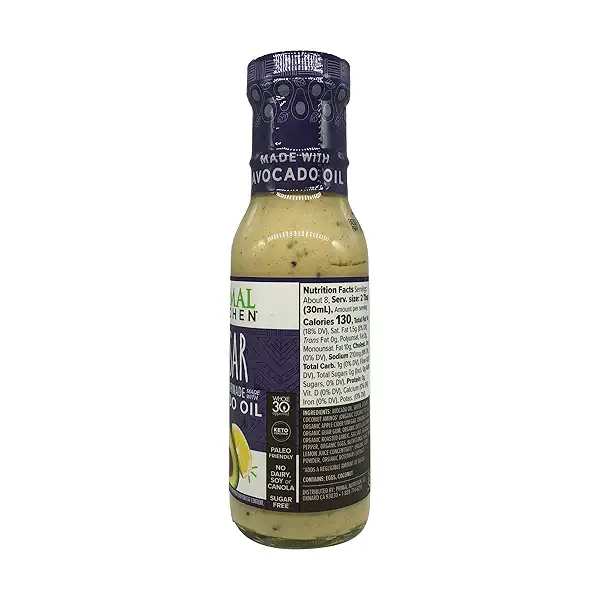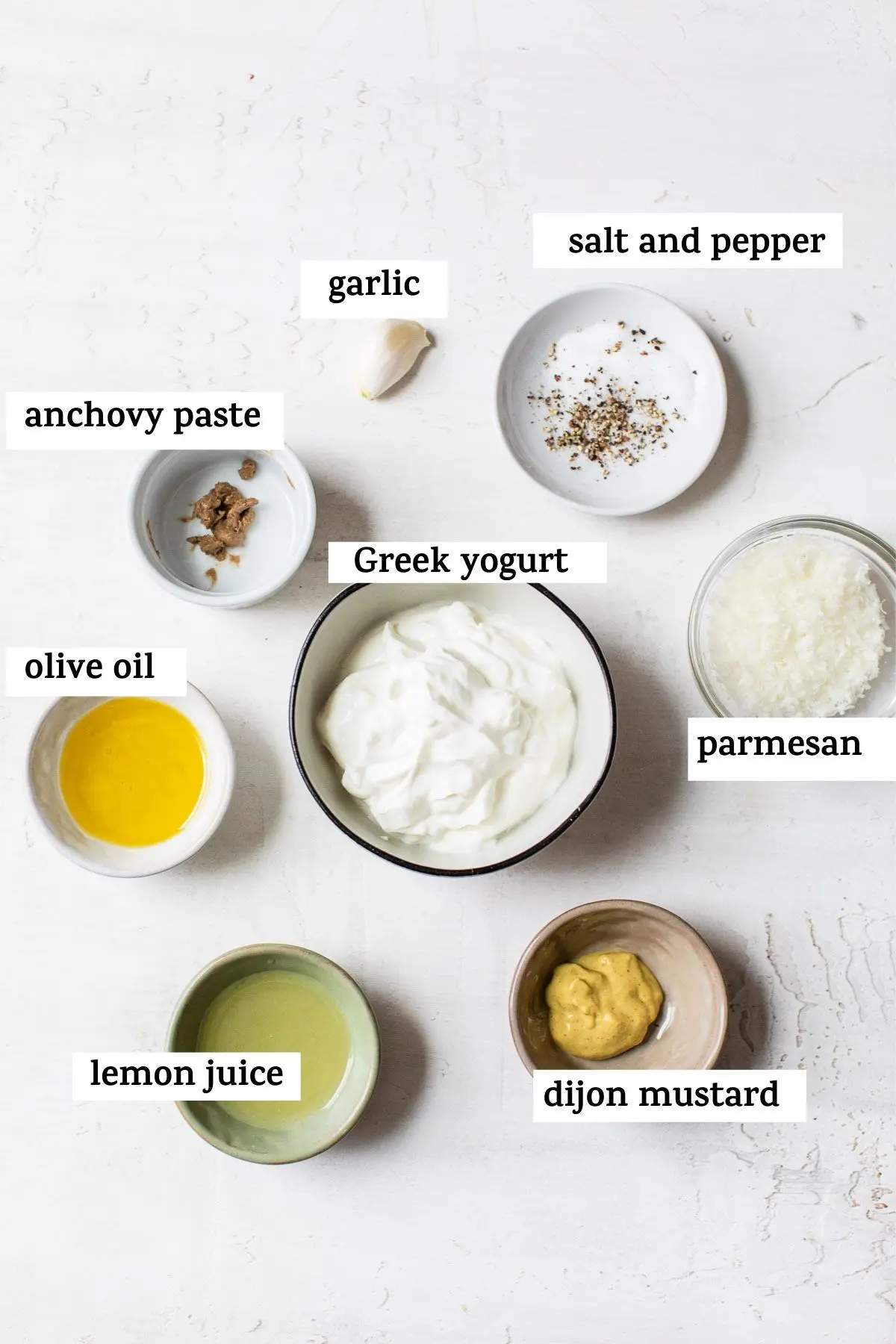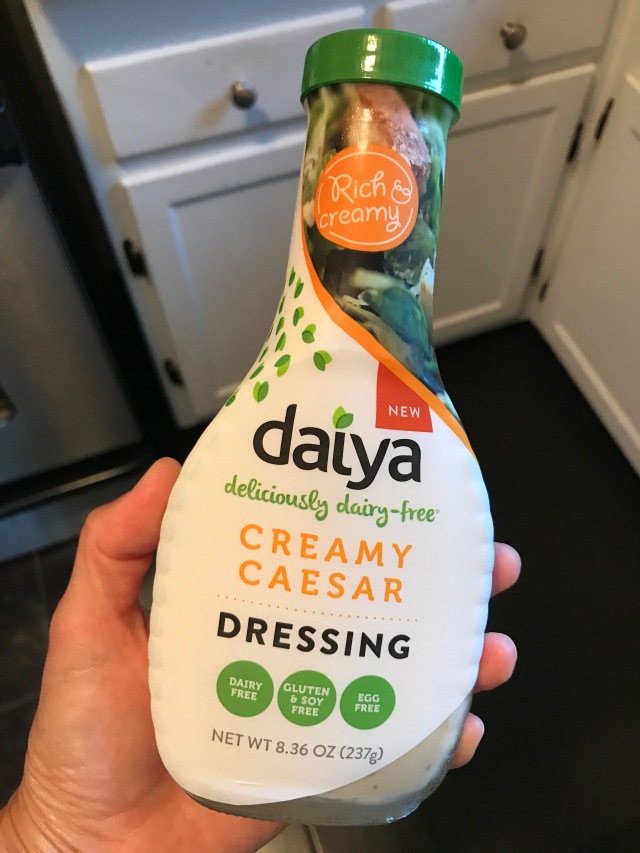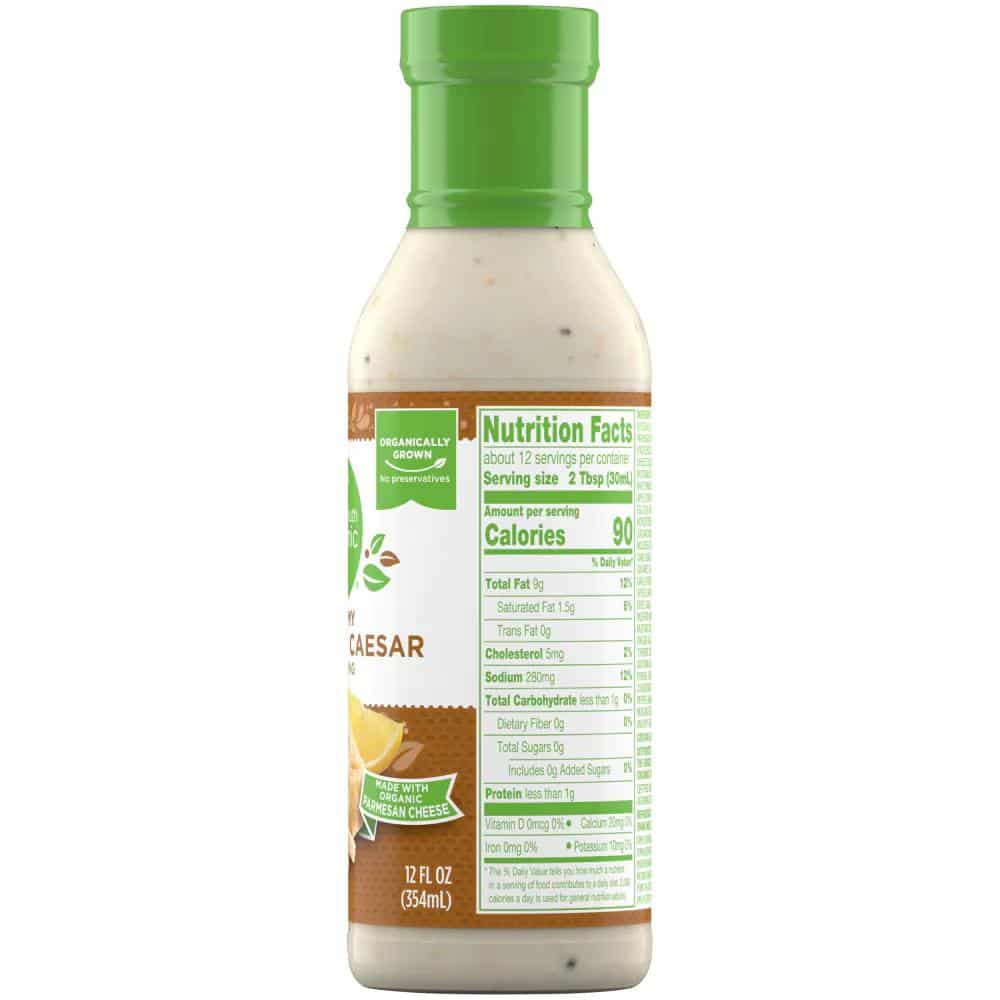
Does Caesar Dressing Typically Contain Dairy?
Yes, traditional Caesar dressing typically contains dairy in the form of Parmesan cheese and sometimes sour cream or milk. However, many modern store-bought versions and homemade recipes offer dairy-free alternatives.
Common Dairy Components in Caesar Dressing:
- Parmesan Cheese: The most common dairy ingredient in Caesar dressing
- Sour Cream: Sometimes added for extra creaminess
- Milk or Cream: Used in some recipes to thin the dressing
- Mayonnaise: While not dairy itself, some commercial mayonnaise contains milk derivatives
Introduction
Get to Know Caesar Dressing
Caesar dressing is that classic sauce people love to pour on their salads since the early 1900s. It’s rich and creamy with a strong taste, and it’s usually made with stuff like garlic, anchovies, Worcestershire sauce, and parmesan cheese. These ingredients come together to create a savory dressing that makes even a simple romaine lettuce feel fancy. The big umami flavor makes it a favorite, but it can be tricky for those who can’t eat dairy.
If you enjoy a nice salad drenched in this creamy goodness, it’s super important to know what’s in it, especially if you’re following certain diets. Whether you’re whipping up your own or grabbing a bottle from the store, finding a Caesar dressing that fits your diet can be a tasty adventure.
Why Dairy-Free Matters
Lately, dairy-free products have really taken off as more folks realize they’re lactose intolerant or have allergies or choose vegan diets. It’s not just about personal choice anymore; it’s about making sure everyone can enjoy food together.
- Health Reasons: Lots of people feel uncomfortable after eating dairy. Having dairy-free dressings makes dining out much more enjoyable.
- Dietary Choices: With the trend leaning toward plant-based meals, it’s super important to have options for those steering clear of animal products.
Dairy-free options usually swap out the classic ingredients with things like nutritional yeast to give that cheesy vibe and emulsifiers like egg yolk to keep it creamy, allowing everyone to enjoy Caesar salad’s great taste regardless of their diet.

Breaking Down Caesar Dressing Ingredients
Traditional Ingredients in Caesar Dressing
Classic Caesar dressing is famous for that creamy goodness that makes every bite of salad sing. The original recipe has a special mix of ingredients that create that signature flavor. Here’s what you usually find in traditional Caesar dressing:
- Egg Yolks: These help blend everything together, adding smoothness and creaminess.
- Anchovies: Often seen as the secret ingredient, they add a deep flavor without being too fishy.
- Garlic: Fresh garlic brings a nice kick that works well with the other rich flavors.
- Worcestershire Sauce: This gives a tangy twist thanks to its mix of spices and vinegar.
- Parmesan Cheese: A must-have in many Caesar dressings, this cheese adds a nutty taste that balances the richness.
- Olive Oil: This oil helps achieve that smooth and velvety texture while adding a hint of fruity flavor.
Every one of these ingredients adds its own unique flavor, making for a dressing that can really amp up any salad.
Common Variations and Add-ins
As with many favorite recipes, variations of Caesar dressing pop up to suit different taste buds and diets. Here are some common changes you might see:
- Dairy-Free Options: For those staying away from dairy, nutritional yeast can be a great stand-in for parmesan, offering that cheesy taste without any lactose.
- Vegan Versions: Swapping out egg yolks for aquafaba (the liquid from chickpeas) is a trendy way to make a vegan version while keeping it creamy.
- Spicy Kicks: Some folks like to spice it up with red pepper flakes or sriracha, giving the dressing a bit of heat.
- Fresh Herbs: You might find fresh herbs like basil or parsley added for a pop of freshness.
Trying out these ingredients lets people create their preferred Caesar dressing while still enjoying those classic flavors.

Does Caesar Dressing Have Dairy?
Dairy in Traditional Recipes
When you look at traditional Caesar dressing, dairy is a big player here—especially parmesan cheese. This rich cheese not only adds a nice nutty taste but also helps make the dressing super creamy that everyone loves. But for those with lactose intolerance or dairy allergies, this can be a real issue. Traditional recipes typically include:
- Parmesan Cheese: A vital ingredient that boosts flavor and umami.
- Mayonnaise (in some versions): Not everybody uses this, but some recipes include it, and it might have dairy.
Since many pre-made dressings contain dairy, it’s important for anyone avoiding dairy to read labels carefully. Some store-bought Caesar dressings pack in around 100 calories per tablespoon with not much nutritional value. Knowing this helps people make better choices about what to put on their salads.
Dairy-Free Options and Substitutes
For those craving that classic Caesar dressing without the dairy, there are some great alternative ingredients that work just as well. Check out these swaps:
- Nutritional Yeast: This mimics that cheesy flavor of parmesan without any lactose.
- Aquafaba: The liquid from chickpeas can replace egg yolks, giving you a vegan-friendly option.
- Cashew Cream: Blended soaked cashews create a rich and creamy base for your dressing.
- Dijon Mustard and Garlic: These add depth and flavor, making sure your dressing doesn’t fall flat.
Using these swaps means you can still dig into a tasty Caesar salad while ditching the dairy and keeping all the flavor intact!

Reading Labels and Know Your Allergens
Why Labels Matter
In today’s food scene, knowing how to read labels isn’t just smart—it’s key for anyone with food restrictions or allergies. Caesar dressing can pack various ingredients, some of which might not sit well with everyone. So checking labels is super important to make sure you get what works for your diet. Here’s why this is a big deal:
- Spotting Dairy: Most traditional Caesar dressings have parmesan cheese and other dairy things that some folks need to avoid.
- Dodging Additives: Packaged dressings often have unhealthy stuff like preservatives and added sugars. Knowing what’s in there helps you pick healthier choices.
- Nutrition Facts: Labels give important info on calories, fat content, sodium, and added sugars. This helps you make choices that fit your health goals.
Taking a few moments to check product labels can save you from surprises later and help make sure your meals are stress-free.
Allergy Awareness for Caesar Dressing Lovers
For those who enjoy Caesar dressing but have allergies, finding the right options can be a bit tricky. Here’s what to keep in mind:
- Dairy Allergies: Most traditional Caesar dressings have dairy. Look for ones clearly marked as “dairy-free” or “no dairy.”
- Egg Allergies: Eggs often pop up in homemade and store-bought Caesar dressings, so be careful if that’s an issue. Vegan options are usually egg-free.
- Fish Allergies: Since anchovies are included in many Caesar dressings, look for ones that don’t have this ingredient if that’s a concern.
- Gluten Sensitivity: Most dressings don’t have gluten, but some brands might use thickeners from wheat, so check the labels closely.
By keeping these tips in mind and making wise choices, you can enjoy your favorite Caesar salad without any worries. Knowing what’s in your food not only helps improve your health but also makes dining more enjoyable!
Making Smart Choices
Tips for Spotting Dairy-Free Caesar Dressing
Searching the grocery store for dairy-free Caesar dressing? It can feel like a lot, but making smart choices isn’t that hard! Here are some tips to make your search easier:
- Read Labels Closely: Always look at the ingredient list for dairy-related items like parmesan cheese or buttermilk. If you’re avoiding eggs too, watch for egg-free options.
- Look for Certifications: Products marked as “dairy-free” or “vegan” are usually better bets. Brands with these labels can ease your mind.
- Check Specialty Stores: Health food stores and farmers’ markets often have more dairy-free options. You could even discover local brands focusing on wholesome ingredients.
- Try Smaller Brands: Big brands have many options, but smaller, artisan brands may surprise you with unique flavors that are dairy-free. Be open to exploring!
Finding the right dressing can really make your salad experience more enjoyable, letting you savor the flavors without any concerns.
DIY Dairy-Free Caesar Dressing Recipe
If you’re feeling creative, making your own dairy-free Caesar dressing at home can be a great way to customize the flavors just how you like them. Here’s a simple recipe to try:
Ingredients:
- 1 raw egg yolk (or 2 tablespoons aquafaba for vegan)
- 2 large garlic cloves, minced
- 4-6 anchovies (or a teaspoon of fish sauce)
- 2 tablespoons stone-ground mustard
- 2 tablespoons nutritional yeast
- 3 tablespoons lemon juice
- 1 teaspoon kosher salt
- 20 cranks of black pepper
- 1/2 cup extra-virgin olive oil
Instructions:
- In a blender, toss in all ingredients except the olive oil and blend until smooth.
- With the blender on low, slowly drizzle in the olive oil over about 3-5 minutes until it all comes together.
- Store in an airtight container in the fridge for a week or so.
This creamy and tasty dressing is great for salads, grilled meats, or even as a dip for veggies. Making it yourself makes sure it fits your dietary needs while keeping that classic Caesar flavor!
Frequently Asked Questions About Caesar Dressing
Is Caesar dressing kosher?
Traditional Caesar dressing is not kosher due to the combination of dairy (Parmesan cheese) and anchovies (fish). However, at Tenafly Kosher Deli, we offer specialized kosher Caesar dressing options that comply with kosher dietary laws.
Can lactose intolerant people eat Caesar dressing?
Most traditional Caesar dressings contain dairy and are not suitable for lactose intolerant individuals. However, dairy-free alternatives are available that replace Parmesan with nutritional yeast or other non-dairy flavoring components.
What can I use instead of Caesar dressing if I’m avoiding dairy?
Excellent dairy-free alternatives include tahini-based dressings, avocado-based dressings, and specially formulated vegan Caesar dressings that use nutritional yeast for the cheesy flavor.
Does Caesar dressing contain eggs?
Yes, traditional Caesar dressing contains raw or coddled eggs, which act as an emulsifier. Many commercial versions use pasteurized eggs for safety. Vegan versions replace eggs with alternatives like aquafaba or plant-based mayo.
How can I tell if a Caesar dressing is dairy-free?
Check the ingredient list for Parmesan cheese, milk, cream, casein, whey, or lactose. Look for “dairy-free” or “vegan” on the label, or opt for products specifically marketed as dairy-free alternatives.
Wrapping it Up
Looking Back at Dairy in Caesar Dressing
As we finish up our look at Caesar dressing, it’s worth noting that this classic condiment usually has dairy, especially from parmesan cheese. This rich, tasty addition is what makes traditional Caesar dressing so appealing. But for those dealing with lactose intolerance, dairy allergies, or folks avoiding dairy for other reasons, this can be an obstacle.
When picking or making Caesar dressing, keep these points in mind:
- Traditional Recipes: Most classical Caesar dressings rely a lot on parmesan for that signature flavor.
- Dairy-Free Alternatives: With the rise of health-conscious diets and various preferences, there are many dairy-free options now that use ingredients like nutritional yeast and non-dairy emulsifiers.
- Homemade Versions: Making your own dressing is a great way to control the ingredients and customize flavors while keeping it dairy-free.
Final Thoughts on Dairy in Caesar Dressing
Knowing what’s in Caesar dressing is key for making smart meal choices. As more people move to diets that skip dairy, the food scene is also catching up by offering more dairy-free options.
For anyone with dietary restrictions, checking labels is a must. Whether you go for store-bought options or decide to whip up your own, being aware of the ingredients in your dressing can boost both your health and enjoyment.
In the end, the versatility of Caesar dressing means you can still enjoy its rich flavors without dairy. There are many creative options out there, so everyone can indulge in this beloved dressing while sticking to their dietary needs!

A Bergen County institution celebrating authentic Jewish cuisine since 1985. Our pastrami—brined for 14 days, smoked over applewood for 12 hours, and steamed to perfection—creates a melt-in-your-mouth experience that rivals Manhattan’s finest delis. Our rye bread is baked fresh daily using a century-old recipe from Poland. Featured in Food & Wine’s “Top 10 Delicatessens in America” and on Food Network’s “Best Thing I Ever Ate.” Chef Moshe Greenbaum, a third-generation deli master trained at the Culinary Institute of America, ensures every sandwich meets our exacting standards. No wonder our customers drive from three states away.
Leave a Reply